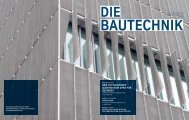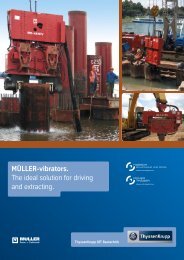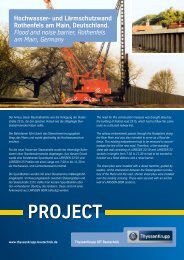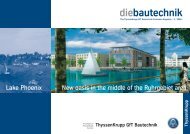pdf (3.6 MB) - ThyssenKrupp Bautechnik
pdf (3.6 MB) - ThyssenKrupp Bautechnik
pdf (3.6 MB) - ThyssenKrupp Bautechnik
You also want an ePaper? Increase the reach of your titles
YUMPU automatically turns print PDFs into web optimized ePapers that Google loves.
AV1<br />
Precision work between storms and waves: vibration technology.<br />
Wind farms require secure foundations which place high demands on dimensional accuracy and other<br />
factors. Deployment under difficult weather conditions at sea, deployment underwater and relatively<br />
low-noise operation are just some of the advantages of vibration technology. More than 60 wind<br />
turbines are planned for the North Sea alone in the coming years. The good properties of steel make<br />
it an ideal material for building such installations.<br />
The alpha ventus transformer station is founded on four tubular steel piles which support a tubular<br />
steel tower. In this project the piles were vibratory driven down to a depth of 31.18 ft with an MS-200<br />
HHF vibrator. Final driving of the piles was carried out with a hydraulic hammer in order to be able to<br />
calculate the loadbearing capacity. This was the first time that vibration technology had been used<br />
successfully in an offshore project. To achieve this pioneering performance, <strong>ThyssenKrupp</strong> GfT<br />
Tiefbautechnik tapped its vast stock of knowledge gained from recent projects involving underwater<br />
foundations for port facilities.<br />
The foundation to the alpha ventus transformer station makes use of four tubular steel piles, each<br />
approx. 128.72 ft long and weighing up to 108.24 US ton. The subsoil here consists of dense to very<br />
dense sand strata. The combination of vibration and impact-driving enabled several conditions to be<br />
fulfilled. After detaching the transport apparatus, the vibrator could be supported directly on the steel<br />
pile, thus holding and aligning it. Consequently, neither a costly and elaborate guiding frame nor an<br />
apparatus for suspending the pile were necessary.<br />
That in turn saved space on the already very congested installation platform and the vertical alignment<br />
of the pile could be achieved with simple means. A pile-mounted vibrator results in simple<br />
vertical installation, an optimum, fast driving time and extremely good economics, too. A mounting<br />
bracket with two clamp grips was used in this project.<br />
The amount of steel used in a wind turbine structure is about 984 US ton, which corresponds to the<br />
weight of 200 fully grown elephants or 22 railway carriages! The rotor catches the wind from an area<br />
roughly equal to one-and-a-half football pitches. At maximum r.p.m., the tips of the rotor blades are<br />
cutting through the air at almost 193.83 mph. It is quite obvious that anchoring this installation<br />
securely to the seabed is a major challenge. Once the transformer station had been constructed, six<br />
wind turbines were erected on foundations comprising so-called tripods – frameworks anchored to the<br />
seabed by means of steel piles. In this project three piles were driven into the seabed per tripod with<br />
the help of MÜLLER vibration technology. The tubular steel piles weigh approx. 127.9-157.4 US ton<br />
each - even heavier than those below the transformer station.<br />
In Germany renewable energy now accounts for about 10% of total energy requirements and just over<br />
15% of the electricity consumption. Some 280 000 people are employed in the manufacture of wind<br />
turbines and solar power installations, in biomass or geothermal energy power plants. This industry is<br />
evolving into an important growth sector of the German economy. Germany is the worldwide leader in<br />
the installed output of wind turbines and photovoltaic installations, also in the export of technologies<br />
for renewable energy.<br />
Source: Alpha Ventus Press picture
















